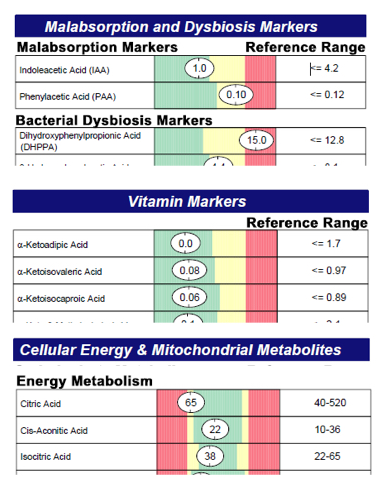Meaningful and accurate assessment of health status often requires analysis of symptoms, and signs. Symptoms can be thought of as subjective reports from a patient regarding a physical disturbance or disease, while a sign can be defined as objective evidence of disease ascertained from biomarkers.1 Biomarkers can be characterized as a measure of pathogenic processes, normal processes, or responses to a nutritional or pharmacological intervention.2(464) Furthermore, such biomarkers can be closely tracked at cellular, molecular, and biochemical levels.2(464) In the following sections, this author would like to briefly elucidate the value and efficacy of tracking biomarkers through a relatively unknown intervention amongst the public; organic acids tests (OATs).
OATs are telling as they are considered intermediates in many biochemical pathways responsible for maintaining homeostasis.3 Such is relevant because if said pathways are functioning optimally, levels of intermediates will be low in the urine. However, if there is a block (which can be due to micronutrient deficiencies and/or insufficient enzyme activity) said organic acid intermediates will be elevated via urine.3(324) For example, one of the benefits of OATs is helping identify functional levels of micronutrients, even when normal levels might be found in serum. That is, serum identifies concentrations of a micronutrient while an OAT might detect its degree of use. Below is a more robust biomarker outline from Lord and Brailley3(324) via OATs:
- Gastrointestinal function
- Detoxification capacity
- Toxin exposure
- Oxidative stress
- Inflammation
- Antioxidant deficiencies
- Vitamin and mineral deficiencies
- Carbohydrate, fat, and amino acid metabolism markers
- Energy production at the mitochondrial level
- Central nervous system function
Please see articles below (click on links) that used OATs, previously written by this author, exploring underlying drivers of various health conditions:
Organic Acid Markers and Intestinal Health
Detoxification, Organic Acids Testing, and Glucarate
B12: Exploring Function, Deficiency, and Toxicity
Bariatric Surgery, Biomarkers, and Nutritional Considerations
Gut Health, Rheumatoid Arthritis, and the Four R Program
Chronic Diarrhea (IBS-D) and the Four R Program
IBS, Biomarkers, and the Four R Program
ADHD, Gut Health, and Nutritional Support
Parkinson’s Disease, Nutrition, and Lifestyle Interventions
Metabolic Syndrome, Biomarkers, and Nutritional Interventions
Small Intestinal Fungal Overgrowth (SIFO) and Nutritional Interventions
Detecting and Managing Small Intestinal Bacterial Overgrowth
In conclusion, meaningful and accurate evaluation of health status requires thorough analysis of symptoms, and signs. Part of an assessment can include review of organic acids biomarkers, providing insights at cellular, molecular, and biochemical levels. Careful interpretation of such tests can help nutritionists and medical professionals direct exercise, nutrition, lifestyle, and pharmacological interventions in a way that is both targeted and precise. Ultimately, as part of a larger and more robust set of evaluations and interventions, OATs can facilitate liberation from illness while providing a pathway towards improved health, performance, and longevity.
References
1. King LS. Signs and symptoms. JAMA. 1968;206(5):1063–1065. doi:10.1001/jama.1968.03150050051011.
2. Strimbu K, Tavel JA. What are biomarkers? Curr Opin HIV AIDS. 2010;5(6):463-466. doi:10.1097/COH.0b013e32833ed177.
3. Lord RS, Bralley JA. Laboratory Evaluations for Integrative and Functional Medicine. 2nd ed. Duluth, GA: Genova Diagnostics; 2012.
-Michael McIsaac

